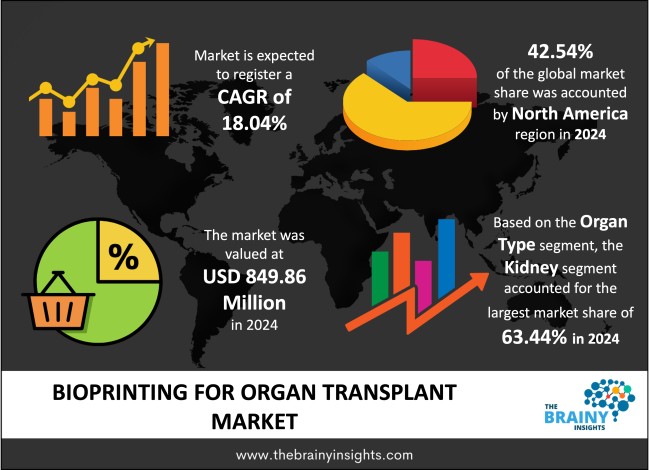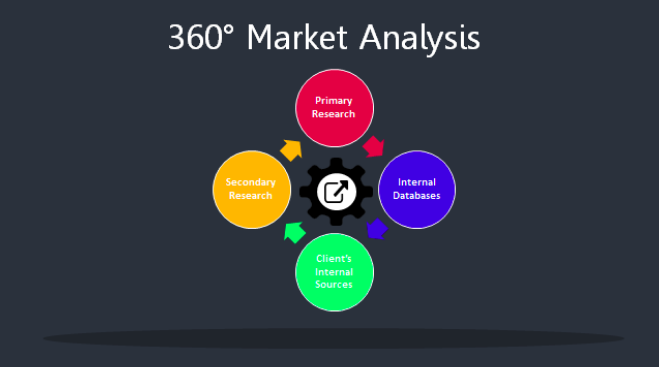- +1-315-215-1633
- sales@thebrainyinsights.com

The global Bioprinting for Organ Transplant market was valued at USD 849.86 Million in 2024 and grew at a CAGR of 18.04% from 2025 to 2034. The market is expected to reach USD 4,463.14 Million by 2034. The market is driven by factors such as thousands of patients dying due to a shortage of organ donors yearly. The use of 3D bioprinting can help in offering unlimited organ supply. Additionally, since organs are printed using the patient's cells, there is no risk of immune rejection. Hence, one does not have to wait for matching donors, and it decreases the time a patient spends on the transplant waiting list. Moreover, it also eliminates access to the organ black market and thus decreases the ethical concerns around organ donation. Additionally, several research centres and leading biotechnology organizations are investing in R&D for the further development of 3D bioprinting. Scientists have had success in printing liver tissue, small kidneys, and heart patches; therefore, the market has a good opportunity for growth.
The bioprinting of human organs with the use of specialized 3D printers is a very promising method for the future of organ transplants. It differs from conventional 3D printing, which typically uses metals and plastics. It aims to fabricate living, functional tissue that suits the human body using bio-ink. This type of bioprinting process begins with the creation of a digital model, which is generated using MRI or CT scans of the actual organs. The model guides the bioprinter, and after the design is set, the bio-ink is then deposited in successive layers. The medical sector in 3D printing accounts for approximately 16% of the total revenue. The surge in the demand for customized medical structures has led to the growing use of 3D printing in the medical field. Moreover, with the expiration of 3D printing, this will become cheaper and more accessible. Open-source 3D printers are being developed to enhance R&D and manufacturing, potentially reducing production costs. For instance, 3D-printed kidney models are widely used to enhance the kidney transplant procedure, which is utilized in surgical planning and training.
Interest and investment in the 3D bioprinting field have increased. Collaboration in research, both within organizations and academia, has increased, leading to the exploration of new boundaries in bioprinting. Additionally, there is the emergence of numerous biofabrication startups and the integration of bioprinting with various other technologies, such as AI. It has increased the pace of innovation in this sector. Bioink has become a cornerstone of 3D bioprinting. It is made of biomaterials, living cells and growth factors. It is the building block of bio-printed structures. The selection of bio-ink-ink is crucial, as it should be biocompatible, offer mechanical support, and promote cell growth. Organ transplantation is suffering from the scarcity of viable organs and the risk of rejection for a long time. Thus, 3D bioprinting provides innovative solutions to such issues by making patient-specific organs and tissues. Patient's cells can be used for the fabrication of bio-printed organs which match the unique physiological and immunological features, thus decreasing the risk of rejection.

Get an overview of this study by requesting a free sample
Growing demand for organ transplantation– The demand for organ transplantation is growing globally due to a surge in the geriatric population and growing cases of chronic diseases. Additionally, advancements in transparent technology are also happening. It has been observed that the transplant rates have increased, but still, the demand is way more than the supply of organs, which is leading to long waiting lists, and there is an urgent requirement for more organ donors. Many chronic diseases such as hypertension, diabetes and kidney diseases are growing, which is leading to many cases of organ failure. Hence, the development of bio-printed organs is looking promising and is attracting a lot of investment, as this could potentially alleviate organ shortages in the future. Based on one of the studies in September 2024, around 103,223 women, men, and children are on the national transplant waiting list in the US and around 13 people die every day as they are waiting for organ transplants. These factors are eventually propelling the growth of the Bioprinting for Organ Transplant market.
Complexities of organs – The printing of simple tissues, such as skin, is currently possible. However, printing complex organs, such as the liver or heart, with viable nerves and blood vessels remains a challenge, and significant investment is being made in R&D to achieve this goal. Additionally, making printed cells alive and functional after transplantation is a significant challenge. Moreover, the technology is still very expensive, and extensive clinical trials are required before 3D-printed organs can be widely used, which necessitates additional capital and time. All these factors are acting as restraints for the market.
Opportunities
Use of AI in bioprinting – 3D bioprinting is a recent technology developed from 3D printing, which uses bioinks that consist of living cells to create tissues. The major development of bioprinting happened in 2002 with the printing of miniature kidneys. After that, scientists can print simple tissues, cartilage, skin grafts and liver tissue. Leading organizations in the market are focusing on developing organ tissue engineering techniques to construct organs, such as kidneys and hearts, that can then be transplanted into the human body. Bioprinting can help create tissues using a patient's cells in a way that ensures the tissue cannot be rejected. The inclusion of technology like AI in the bioprinting process can aid in the growth of bioprinting for the organ transplant market. AI can help analyze large datasets and predict outcomes. It also helps in optimizing the process. AI has become crucial in optimizing biomaterials used in bioprinting, substantially streamlining the process. For instance, AI helps analyze large datasets from previous experiments and quickly identifies the most suitable bio-inks across various tissue types. This helps decrease the time spent on trial and error, saving many years of research. All these factors are eventually increasing the demand for the use of Bioprinting for Organ Transplant in the forecasting period.
The regions analysed for the market include North America, Europe, South America, Asia Pacific, the Middle East, and Africa. North America emerged as the most significant global Bioprinting for Organ Transplant market, with a 42.54% market revenue share in 2024.
The North American region leads the Bioprinting for Organ Transplant market, which is attributed to the advanced healthcare infrastructure in the US. There is substantial investment happening in bioprinting technologies and biotechnology. The US is leading the field of medical research and development, and many educational institutions and research centres are focusing on the advancement of bioprinting. Moreover, there are government regulations which support healthcare innovations. These factors are creating a high demand for Bioprinting for Organ Transplant in the region.
North America Region Bioprinting for Organ Transplant Market Share in 2024 – 42.54%
www.thebrainyinsights.com
Check the geographical analysis of this market by requesting a free sample
The organ type segment is divided into liver, heart, kidney, lung, skin and others. Kidney segment dominated the market, with a market share of around 63.44% in 2024. The kidney is a crucial organ of human life that maintains the body's fluid balance and helps filter waste from the blood. In 2016, a team of Scientists at Harvard developed a new bioprinting method capable of producing proximal tubes that make up the kidney.
The process segment is divided into inkjet bioprinting, extrusion based bioprinting, laser assisted bioprinting, acoustic bioprinting, magnetic bioprinting and others. The extrusion based bioprinting segment dominated the market, with a market share of around 48.73% in 2024. This significant share is due to its capability of handling a broad range of bio-inks, including cell suspensions and hydrogels. Thus, it is suitable for a wide range of tissue types. Its demand is growing in the biomedical field, particularly in regenerative medicine and tissue engineering, because of its versatility and comparatively lower cost. It is also easy to use and hence become a popular choice for 3D bioprinting.
| Attribute | Description |
|---|---|
| Market Size | Revenue (USD Million) |
| Market size value in 2024 | USD 849.86 Million |
| Market size value in 2034 | USD 4,463.14 Million |
| CAGR (2025 to 2034) | 18.04% |
| Historical data | 2021-2023 |
| Base Year | 2024 |
| Forecast | 2025-2034 |
| Region | The regions analyzed for the market are Asia Pacific, Europe, South America, North America, and Middle East and Africa. Furthermore, the regions are further analyzed at the country level. |
| Segments | Organ Type and Process |
As per The Brainy Insights, the size of the global Bioprinting for Organ Transplant market was valued at USD 849.86 Million in 2024 to USD 4,463.14 Million by 2034.
Global Bioprinting for Organ Transplant market is growing at a CAGR of 18.04% during the forecast period 2025-2034.
The market's growth will be influenced by growing demand for organ transplantation.
Complexities of organs could hamper the market growth.
This study forecasts revenue at global, regional, and country levels from 2021 to 2034. The Brainy Insights has segmented the global Bioprinting for Organ Transplant market based on below mentioned segments:
Global Bioprinting for Organ Transplant Market by Organ Type:
Global Bioprinting for Organ Transplant Market by Process:
Global Bioprinting for Organ Transplant Market by Region:
Research has its special purpose to undertake marketing efficiently. In this competitive scenario, businesses need information across all industry verticals; the information about customer wants, market demand, competition, industry trends, distribution channels etc. This information needs to be updated regularly because businesses operate in a dynamic environment. Our organization, The Brainy Insights incorporates scientific and systematic research procedures in order to get proper market insights and industry analysis for overall business success. The analysis consists of studying the market from a miniscule level wherein we implement statistical tools which helps us in examining the data with accuracy and precision.
Our research reports feature both; quantitative and qualitative aspects for any market. Qualitative information for any market research process are fundamental because they reveal the customer needs and wants, usage and consumption for any product/service related to a specific industry. This in turn aids the marketers/investors in knowing certain perceptions of the customers. Qualitative research can enlighten about the different product concepts and designs along with unique service offering that in turn, helps define marketing problems and generate opportunities. On the other hand, quantitative research engages with the data collection process through interviews, e-mail interactions, surveys and pilot studies. Quantitative aspects for the market research are useful to validate the hypotheses generated during qualitative research method, explore empirical patterns in the data with the help of statistical tools, and finally make the market estimations.
The Brainy Insights offers comprehensive research and analysis, based on a wide assortment of factual insights gained through interviews with CXOs and global experts and secondary data from reliable sources. Our analysts and industry specialist assume vital roles in building up statistical tools and analysis models, which are used to analyse the data and arrive at accurate insights with exceedingly informative research discoveries. The data provided by our organization have proven precious to a diverse range of companies, facilitating them to address issues such as determining which products/services are the most appealing, whether or not customers use the product in the manner anticipated, the purchasing intentions of the market and many others.
Our research methodology encompasses an idyllic combination of primary and secondary initiatives. Key phases involved in this process are listed below:

The phase involves the gathering and collecting of market data and its related information with the help of different sources & research procedures.

The data procurement stage involves in data gathering and collecting through various data sources.
This stage involves in extensive research. These data sources includes:
Purchased Database: Purchased databases play a crucial role in estimating the market sizes irrespective of the domain. Our purchased database includes:
Primary Research: The Brainy Insights interacts with leading companies and experts of the concerned domain to develop the analyst team’s market understanding and expertise. It improves and substantiates every single data presented in the market reports. Primary research mainly involves in telephonic interviews, E-mail interactions and face-to-face interviews with the raw material providers, manufacturers/producers, distributors, & independent consultants. The interviews that we conduct provides valuable data on market size and industry growth trends prevailing in the market. Our organization also conducts surveys with the various industry experts in order to gain overall insights of the industry/market. For instance, in healthcare industry we conduct surveys with the pharmacists, doctors, surgeons and nurses in order to gain insights and key information of a medical product/device/equipment which the customers are going to usage. Surveys are conducted in the form of questionnaire designed by our own analyst team. Surveys plays an important role in primary research because surveys helps us to identify the key target audiences of the market. Additionally, surveys helps to identify the key target audience engaged with the market. Our survey team conducts the survey by targeting the key audience, thus gaining insights from them. Based on the perspectives of the customers, this information is utilized to formulate market strategies. Moreover, market surveys helps us to understand the current competitive situation of the industry. To be precise, our survey process typically involve with the 360 analysis of the market. This analytical process begins by identifying the prospective customers for a product or service related to the market/industry to obtain data on how a product/service could fit into customers’ lives.

Secondary Research: The secondary data sources includes information published by the on-profit organizations such as World bank, WHO, company fillings, investor presentations, annual reports, national government documents, statistical databases, blogs, articles, white papers and others. From the annual report, we analyse a company’s revenue to understand the key segment and market share of that organization in a particular region. We analyse the company websites and adopt the product mapping technique which is important for deriving the segment revenue. In the product mapping method, we select and categorize the products offered by the companies catering to domain specific market, deduce the product revenue for each of the companies so as to get overall estimation of the market size. We also source data and analyses trends based on information received from supply side and demand side intermediaries in the value chain. The supply side denotes the data gathered from supplier, distributor, wholesaler and the demand side illustrates the data gathered from the end customers for respective market domain.

The supply side for a domain specific market is analysed by:
The demand side for the market is estimated through:
In-house Library: Apart from these third-party sources, we have our in-house library of qualitative and quantitative information. Our in-house database includes market data for various industry and domains. These data are updated on regular basis as per the changing market scenario. Our library includes, historic databases, internal audit reports and archives.
Sometimes there are instances where there is no metadata or raw data available for any domain specific market. For those cases, we use our expertise to forecast and estimate the market size in order to generate comprehensive data sets. Our analyst team adopt a robust research technique in order to produce the estimates:
Data Synthesis: This stage involves the analysis & mapping of all the information obtained from the previous step. It also involves in scrutinizing the data for any discrepancy observed while data gathering related to the market. The data is collected with consideration to the heterogeneity of sources. Robust scientific techniques are in place for synthesizing disparate data sets and provide the essential contextual information that can orient market strategies. The Brainy Insights has extensive experience in data synthesis where the data passes through various stages:


Market Deduction & Formulation: The final stage comprises of assigning data points at appropriate market spaces so as to deduce feasible conclusions. Analyst perspective & subject matter expert based holistic form of market sizing coupled with industry analysis also plays a crucial role in this stage.
This stage involves in finalization of the market size and numbers that we have collected from data integration step. With data interpolation, it is made sure that there is no gap in the market data. Successful trend analysis is done by our analysts using extrapolation techniques, which provide the best possible forecasts for the market.
Data Validation & Market Feedback: Validation is the most important step in the process. Validation & re-validation via an intricately designed process helps us finalize data-points to be used for final calculations.

The Brainy Insights interacts with leading companies and experts of the concerned domain to develop the analyst team’s market understanding and expertise. It improves and substantiates every single data presented in the market reports. The data validation interview and discussion panels are typically composed of the most experienced industry members. The participants include, however, are not limited to:
Moreover, we always validate our data and findings through primary respondents from all the major regions we are working on.
Free Customization
Fortune 500 Clients
Free Yearly Update On Purchase Of Multi/Corporate License
Companies Served Till Date